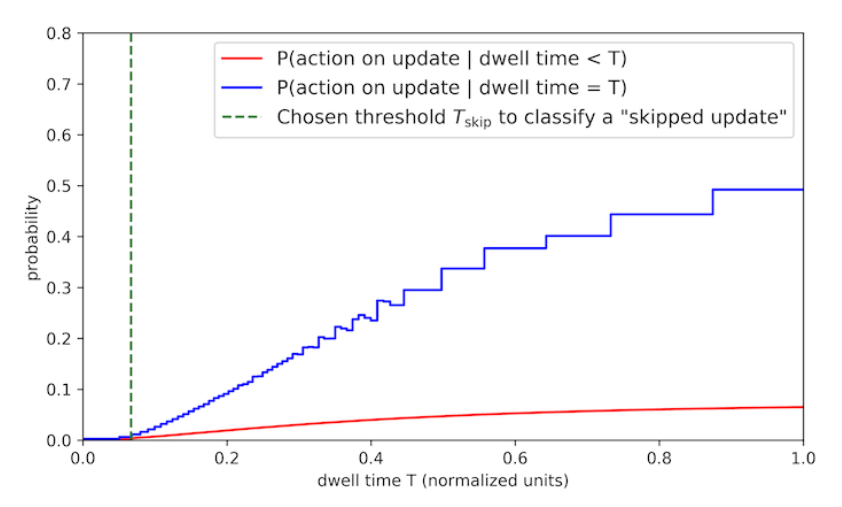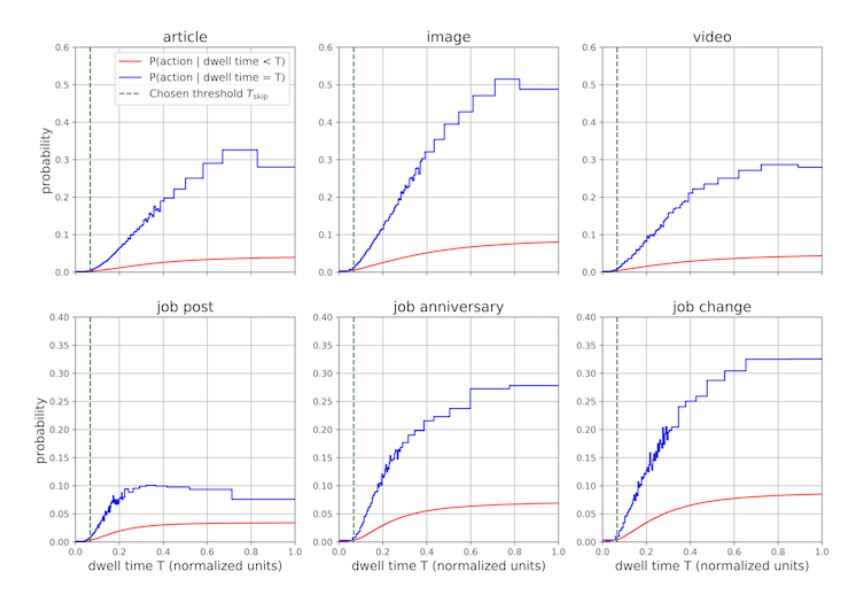Linkedin’s engineers published the recipe for their new algorithm on May 12, 2020. The least we can say is that it completely changes the practice of making a post go viral. If you want your LinkedIn posts to be seen (and incidentally become popular), read the following carefully. See also the “data” analyses that we dedicate to the factors that boost visibility on Linkedin: hashtags, word count, emojis.
In a nutshell (if you only have 30 seconds)
What is changing
- likes and comments are no longer taken directly into account (check this 2022 analysis on 57 unpublished statistics on Linkedin where we discuss Likes and Comments)
- the main factor in determining whether a post should be “pushed” is the amount of time spent interacting with it
- minimum interaction time is defined below which a post is not worth being displayed by the algorithm
The consequences for you
- don’t count on automation (pods) to boost your LinkedIn publications any more
- your content should catch the attention: use images, specific typography, and emojis to “stand out”.
- your content should retain the user: include interactive content (images containing information, presentations)
- the external links will be even more penalising than before because they will take the user out of LinkedIn and will decrease the time spent on the post
Summary
- Introduction
- Why change the rules of the algorithm?
- How does the new algorithm work?
- The impact on your use of LinkedIn
- The contents to be favoured
- How to increase the chances of going viral on LinkedIn

Introduction
LinkedIn is deploying a new version of its algorithm. The rules of the game to increase the reach of its posts are changing. The likes and comments that made a post go viral have been abandoned in favour of another metric. As a result, the opening rate of external links will decrease further. As I showed here, the rate was barely 1.39%.
Why change the rules of Linkedin’s algorithm?
Until now, the LinkedIn algorithm used 3 types of explicit feedback to score and recommend the publication. These 3 factors were:
- the reactions (like, celebrate, love,) that allowed different types of emotions to materialise as Facebook had done (except that at LinkedIn these various factors never played a decisive role)
- Comments
- Sharing
The formula was simple, too simple. So, it was easy to hack, mainly thanks to engagement pods, groups of people who like and comment on posts from their community.
End of playtime!
In practice, how does Linkedin’s new algorithm work?
The LinkedIn developers are kind because they explain their recipe to you. To make it simple, they have determined a minimum time (T skip) that characterises the materialisation of possible interest for a post. If the time you spend on a post is less than T skip, you are deemed not to show interest in the publication.
The graph below gives an account of their work.
The probability of reacting with the post is constant and almost zero when the time spent is less than T skip (red curve). On the other hand, the probability of reacting increases for posts with which the interaction time is longer than T skip (blue curve).
In Linkedin’s new algorithm, the reactions thus become a by-product of the interaction time. The responses are only the visible signals of an underlying “interest” variable whose measurement is operated through the interaction time.
Reactions (likes, comments, sharing) are only visible signals of interest in a LinkedIn publication. Interest grows with the time spent on the publication. The likelihood of receiving a like, comment or share also increases.
What difference does this make to my use of LinkedIn?
If you are, like 99% of LinkedIn users, a content consumer rather than a content producer, the new algorithm should, in theory, offer you more content to suit your tastes. Sorting will be done based on your past interactions.
If you are a content producer, Linkedin’s new algorithm will revolutionise your use of this social network. Indeed, you will have to think about how to engage the community, how to get your posts noticed and how to increase interaction time.
What content should I prioritise to take advantage of Linkedin’s new algorithm?
The LinkedIn developers’ article gives us some food for thought on how to do this. The results have been classified according to the type of content. I was surprised to see the images seem to make people react more quickly and more frequently. All other things being equal, we note that the probability of reaction with an image (P=0.3) is 50% higher for the same normalised viewing time (T=0.2) as an article or a video.
Images, therefore, make people react more quickly and more frequently.

The second thing we learn from the simulations is that articles are slightly more effective than videos at T>0.6.
So, it seems natural to want to combine image and article to combine their effects.
How to maximise the chances of going viral with Linkedin’s new algorithm?
From the information distilled above, it appears that it is now necessary to prepare one’ s content to increase the interaction time. We can, therefore, exclude short contents, hypertext links without explanations, …
In my opinion, it is necessary to proceed as follows:
- use an image to attract attention and start engagement (intuitively I would tend to use a picture with a slogan to make people react and arouse curiosity)
- Continue the engagement with textual content: take care of your hat to make users want to click on “see more”.
Small format presentations are a type of content that I think is particularly suitable for generating engagement, provided they are explicitly designed for LinkedIn. I still see too many people putting presentations online without touching them up: cluttered content, fonts that are too small, neutral colours… If you want to stand out and grab attention, there’s no secret: you’ll have to work and make some effort in terms of design. You will find below an example of a presentation I created for the French version of my May 25 article. I’m not saying it’s perfect, but I tried my best to respect my audience by offering them a visually appealing and synthetic content.
What is clear is that it is far from the time when the same content could be posted on different social networks without being edited. Today you have to adapt your content to each social network, but you also have to keep up to date with the latest algorithms. This monitoring work is essential for those who still want to animate a community, especially on LinkedIn.
Posted in big data.
17 May 2021
How do you keep up with the algorithms of various social media? I discovered your article embedded in another post. I’m trying to discover ways to stay abreast of all the changes and modifications, but finding it very challenging. Please help?!
18 May 2021
keeping up with the various algorithms is a real challenge for at least 2 reasons :
– each algorithm is different
– the algorithms are frequently updated
For those reasons you can’t really build a unique understanding of how *all¨* algorithms work. However I believe it’s possible using some basic understanding of how an algorithm works, to optimize one’s post.
All algorithms use scoring to rank the posts. The content of the post is what really matters. Most people get it wrong as they focus on the “signals”, i.e. the visible indicators of a post’s success. But you have to get back to the essence : why was this very post sucessful at all, or why was this post more successful than another post of the ame author.
This leads you back on Linkedin to the semantic aspects of the posts and this is what I’m researching now.
If you like my study and what to support me, please mention my posts. Thank you.
16 April 2022
Great article! How did you get data? How big is the sample?
18 April 2022
the dataset contains 4.6 millions posts